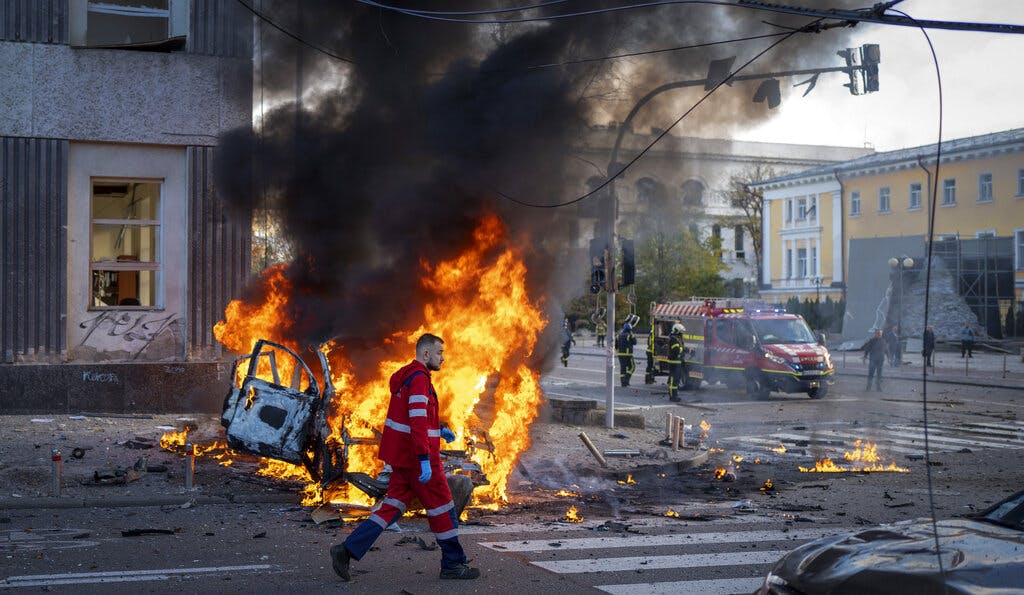Vladimir Putin Loses His Temper
An unambiguous attempt to break Ukraine’s fighting spirit.

Even by the standard of the Russian behavior in the war in Ukraine, Monday’s cascade of missiles targeting civilian areas was a shockingly barbaric barrage. Striking at rush hour, President Putin rained something like 108 missiles and drones on 11 Ukrainian cities, including seven in largely untouched western Ukraine. Most hit civilian targets, in what was an unambiguous attempt to break Ukraine’s fighting spirit.
Fat chance, is our guess. Two attacks hit symbolic targets in Kyiv, Ukraine’s political, economic, and news capital. One missile engulfed in an orange fireball a popular tourist attraction — a three-year-old glass bridge. Connecting two hills above the Dnipro River, the bridge afforded visitors a sweeping view of the site where Prince Volodomyr Christianized the Kyiv Rus with a mass baptism in 988 of the common era.
Another missile exploded on Taras Shevchenko Boulevard, a central avenue noted for its museum, park, university, and soaring monument to the 19th-century poet revered as the father of the Ukrainian language. Over the last decade, in a throughgoing de-communization and de-Russification movement, 1,320 Lenin statues have been torn down across Ukraine, many replaced with statues of Shevchenko, a symbol of Ukraine’s national struggle.
This morning, photos show the smoking ruins of the brightly colored children’s playground in Shevchenko Park. Our contributor James Brooke tells us that he used to walk his son, George, to play on the park’s slides, swings, and jungle gym. Today no military target was in sight. The blast blew out windows on a long series of Beaux Arts-style buildings, including one of the capital’s best art museums and all peaceful.
What is the point of it for Mr. Putin at this point? In today’s bombing raids, at least 10 people were killed, and scores injured. Tens of thousands more sheltered in basement bomb shelters and subway stations. On a crisp fall day, swaths of the nation were left without heat, water, or power. Plus, too, Mr. Putin’s attacks on civilian and peaceable places are likely to push Ukrainians to further dig in their heels.
Certainly polls are suggesting that seven months of war have pushed popular support for acceding to the North Atlantic Treaty to record levels. In a poll of 2,000 Ukrainians conducted between October 1 and October 2 by Kyiv’s Rating Group, 83 percent said they would vote to join the Western military alliance. Only 4 percent said they would vote against it in a referendum. One year ago, a similar poll put Ukrainian support at only 55 percent.
Mr. Putin’s conduct of the war shows that he no longer hopes to win the hearts and minds of Ukrainians. Until today, the main victims of his war have been Russian-speaking Ukrainians. Starting last spring with the bloody siege of Kyiv, a bilingual city, the offensive has devastated a 1,000-mile arc of cities that are culturally and linguistically closest to Russia — Chernihiv, Sumy, Kharkiv, Severodonetsk, Mariupol, Kherson, and Mykolaiv.
Kharkiv, only 25 miles west of Russia, is — or was — Ukraine’s second largest city and an overwhelmingly Russian-speaking city. Mr. Putin’s artillery, firing from across the border, destroyed one-quarter of the housing stock of the city, which had a population of 1.4 million people. Mariupol, once Ukraine’s main port on the Sea of Azov, was leveled the way that Russian bombers flattened Aleppo, Syria, in 2015 and 2016.
President Zelensky, reviewing Russia’s tactics, declared Monday: “They are trying to destroy us and wipe us off the face of the earth.” With China and India publicly distancing themselves from Mr. Putin, though, the Russian leader’s status is indisputably one of an international pariah. That may be old news, but it’s also a symptom of something that is becoming clearer by the day, that Mr. Putin knows he is losing not only Ukraine but his own last chance.

